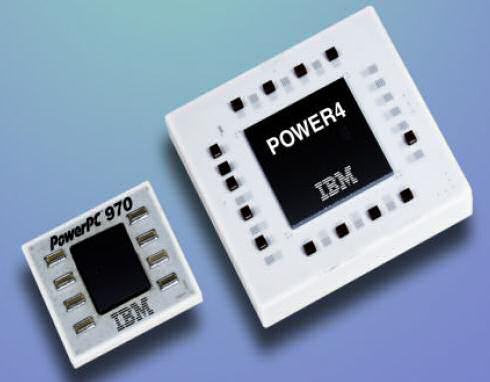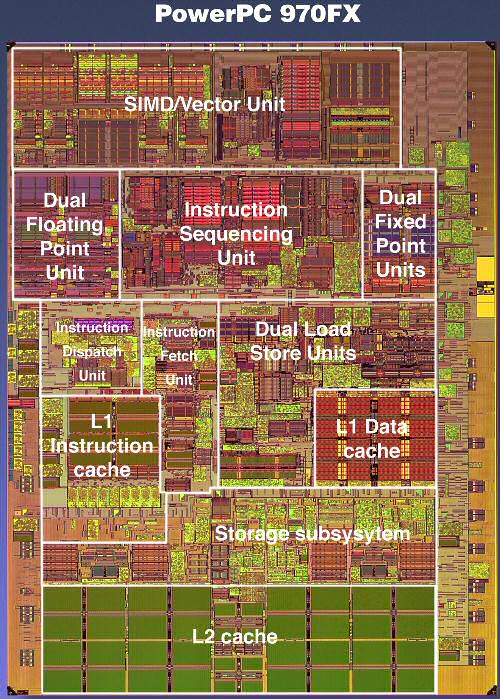No more mysteries: Apple's G5 versus x86, Mac OS X versus Linux
by Johan De Gelas on June 3, 2005 7:48 AM EST- Posted in
- Mac
IBM PowerPC 970FX: Superscalar monster
Meet the G5 processor, which is in fact IBM's PowerPC 970FX processor. The RISC ISA, which is quite complex and can hardly be called "Reduced" (The R of RISC), provides 32 architectural registers. Architectural registers are the registers that are visible to the programmer, mostly the compiler programmer. These are the registers that can be used to program the calculations in the binary (and assembler) code.
The 970FX is deeply pipelined, quite a bit deeper than the Athlon 64 or Opteron. While the Opteron has a 12 stage pipeline for integer calculations, the 970FX goes deeper and ends up with 16 stages. Floating point is handled through 21 stages, and the Opteron only needs 17. 21 stages might make you think that the 970FX is close to a Pentium 4 Northwood, but you should remember that the Pentium 4 also had 8 stages in front of the trace cache. The 20 stages were counted from the trace cache. So, the Pentium 4 has to do less work in those 20 stages than what the 970FX performs in those 16 or 21 stages. When it comes to branch prediction penalties, the 970FX penalty will be closer to the Pentium 4 (Northwood). But when it comes to frequency headroom, the 970FX should do - in theory - better than the Opteron, but does not come close to the "old" Pentium 4.

The 970FX works out of order and up to 200 instructions can be kept in flight, compared to 126 in the Pentium 4. The rate at which instructions are fetched will not limit the issue rate either. The PowerPC 970 FX fetches up to 8 instructions per cycle from the L1 and can decode at the same rate of 8 instructions per cycle. So, is the 970FX the ultimate out-of-order CPU?
While 200 instructions in flight are impressive, there is a catch. If there was no limitation except die size, CPUs would probably keep thousands of instructions in flight. However, the scheduler has to be able to pick out independent instructions (instructions that do not rely on the outcome of a previous one) out of those buffers. And searching and analysing the buffers takes time, and time is very limited at clock speeds of 2.5 GHz and more. Although it is true that the bigger the buffers, the better, the number of instructions that can be tracked and analysed per clock cycle is very limited. The buffer in front of the execution units is about 100 instructions big, still respectable compared to the Athlon 64's reorder buffer of 72 instructions, divided into 24 groups of 3 instructions.
The same grouping also happens on the 970FX or G5. But the grouping is a little coarser here, with 5 instructions in one group. This grouping makes reordering and tracking a little easier than when the scheduler would have to deal with 100 separate instructions.
The grouping is, at the same time, one of the biggest disadvantages. Yes, the Itanium also works with groups, but there the compilers should help the CPU with getting the slots filled. In the 970FX, the group must be assembled with pretty strict limitations, such as at one branch per group. Many other restrictions apply, but that is outside the scope of this article. Suffice it to say that it happens quite a lot that a few of the operations in the group consist of NOOP, no-operation, or useless "do nothing" instructions. Or that a group cannot be issued because some of the resources that one member of the group needs is not available ( registers, execution slots). You could say that the whole grouping thing makes the Superscalar monster less flexible.
Branch prediction is done by two different methods each with a gigantic 16K entry history table. A third "selector" keeps another 16K history to see which of the two methods has done the best job so far. Branch prediction seems to be a prime concern for the IBM designers.
Memory Subsystem
The caches are relatively small compared to the x86 competition. A 64 KB I-cache and 32 KB D-cache is relatively "normal", while the 512 KB L2-cache is a little small by today's standards. But, no complaints here. A real complaint can be lodged against the latency to the memory. Apple's own webpage talks about 135 ns access time to the RAM. Now, compare this to the 60 ns access time that the Opteron needs to access the RAM, and about 100-115 ns in the case of the Pentium 4 (with 875 chipset).A quick test with LM bench 2.04 confirms this:
| Host | OS | Mem read (MB/s) | Mem write (MB/s) | L2-cache latency (ns) | RAM Random Access (ns) |
| Xeon 3.06 GHz | Linux 2.4 | 1937 | 990 | 59.940 | 152.7 |
| G5 2.7 GHz | Darwin 8.1 | 2799 | 1575 | 49.190 | 303.4 |
| Xeon 3.6 GHz | Linux 2.6 | 3881 | 1669 | 78.380 | 153.4 |
| Opteron 850 | Linux 2.6 | 1920 | 1468 | 50.530 | 133.2 |
Memory latency is definitely a problem on the G5.
On the flipside of the coin is the excellent FSB bandwidth. The G5/Power PC 970FX 2.7 GHz has a 1.35 GHz FSB (Full Duplex), capable of sending 10.8 GB/s in each direction. Of course, the (half duplex) dual channel DDR400 bus can only use 6.4 GB/s at most. Still, all this bandwidth can be put to good use with up to 8 data prefetch streams.










116 Comments
View All Comments
Reflex - Friday, June 3, 2005 - link
NT was designed primarily by Dave Cutler, who was one of the guys behind VMS at DEC. NT is not based on Mach and has no relation to it, although it shares some similarities with BSD and VMS.tfranzese - Friday, June 3, 2005 - link
#35, Apple's platform uses HT links (don't ask me specifics).minsctdp - Friday, June 3, 2005 - link
What's with the 24 MB/s memory write time on the Xeon, vs. nearly 2GB/s for the others? Looks bogus.querymc - Friday, June 3, 2005 - link
I'd still like to see a Linux on G5 test. Without one, we still don't know for sure whether the bad performance is due to OS X or the hardware. And it's definitely useful for G5 owners to know whether they can expect Linux to improve server performance.querymc - Friday, June 3, 2005 - link
NT is not built on Mach. NT itself was originally a microkernel-based OS, derived from the design of DEC's VMS OS via the lead architect of both, Dave Cutler. It's currently very monolithic, a bit more than OS X because they stuffed a lot of userspace cruft from Windows 9X in the XP kernel for binary compatibility.Rick Rashid(sp?) was one of the co-developers of Mach, and he went to Microsoft, which is probably what OddTSI is referring to. I don't recall whether he went to research or the OS group, though. Either way, NT has no Mach code and does not share Mach's design.
Netopia - Friday, June 3, 2005 - link
OddTSI (Poster 37)-- Do you have any supporting data for saying that NT is built on Mach?Joe
AluminumStudios - Friday, June 3, 2005 - link
Intersting article. I wish you hadn't left out AfterEffects though because I use it heavily and I'd love to see a comparison between the Mac and x86 on it.OddTSi - Friday, June 3, 2005 - link
There's a semi-big error in your discussion on page 7. NT (and the subsequent Windows OSes based on it) is NOT a monolithic OS. In fact NT is BASED ON MACH. The main developer for the Mach micro-kernel was one of the lead developers of NT.octanelover - Friday, June 3, 2005 - link
I think it would be interesting, on the server side of things, to include Solaris 10 on Opteron in your benchmark list. Seeing as how Solaris is still a major player in the server world it would be nice to see how it fares along with Linux and Mac OSX.By the way, this article, IMHO, is darn near groundbreaking. Excellent work and very illuminating.
exdeath - Friday, June 3, 2005 - link
And before we talk about 10 Gb/sec busses, don't forget the Opteron can have like what 3 HT channels?And Hyper Transport specs allow for 22 GB/sec per channel (11 GB/sec bidirectional?)